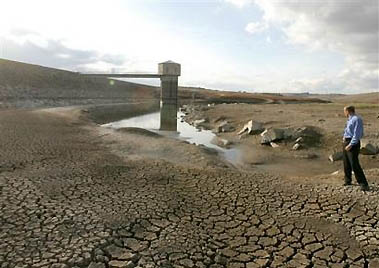Rapidly
shrinking Arctic ice -
it spells trouble for the rest of the world
by Robert S. Boyd on 10 January 2006 for Knight Ridder Newspapers
Alarmed by an
accelerating loss of ice in the Arctic Ocean, scientists are striving
to understand why the speedup is happening and what it means for
humankind.
If present trends continue, as seems likely, the sea surrounding
the North Pole will be completely free of ice in the summertime
within the lifetime of a child born today. The loss could point
the way to radical changes in the Earth's climate and weather systems.
Some researchers, such as Ron Lindsay, an Arctic scientist at the
University of Washington in Seattle, fear that the polar region
already may have passed a "tipping point" from which it
can't recover in the foreseeable future.
Others, such as Jonathan Overpeck, the director of the Institute
for the Study of Planet Earth at the University of Arizona in Tucson,
think the Arctic ice pack is nearing a point of no return but hasn't
reached it yet.
The National Science Foundation, a congressionally chartered agency,
last month announced an urgent research program to determine what
"these changes mean for both the Arctic and the Earth."
"The pace of Arctic change has accelerated," the foundation
declared. "Because of the Arctic's pivotal role in the Earth's
climate, it is critical - perhaps urgent - that we understand this
system in light of abundant evidence that a set of linked and pervasive
changes are under way."
The concern has heightened because last summer brought a record
low in the size of the northern ice pack. "The degree of retreat
was greater than ever before," said Ted Scambos, chief scientist
at the National Snow and Ice Data Center in Boulder, Colo. Previous
lows were set in 2002, 2003 and 2004.
Since 1980, satellite observations taken each September, the warmest
month of the year in the Arctic, show that the ice cover has been
shrinking by an average of almost 8 percent a year. During that
time, the polar ocean lost 540,000 square miles of ice - an area
twice the size of Texas, Scambos said.
As a result, ships were able to sail freely, without the usual aid
of an icebreaker, across the northern rim of Siberia last summer.
Polar bears and Inuit natives found it harder to hunt and fish on
the dwindling ice.
In addition to covering a smaller area of the ocean, the remaining
ice is getting thinner. Submarine measurements indicate that the
central ice pack thinned by 40 percent from the 1960s to the 1990s,
Lindsay reported in the November issue of the Journal of Climate.
Scientists say the great Arctic thaw will have effects all over
the world, not just in the frozen north. It will magnify the global
warming trend that's been recorded for the last quarter-century.
It'll reshape the Earth's weather systems in unknown ways. It could
alter the pattern of ocean circulation, drastically changing Europe's
climate.
"Loss of ice on land is also taking place at an accelerating
rate, and this means sea levels will rise globally," Lindsay
said. "Places like New Orleans will become even less viable."
There are two main reasons for the loss of Arctic sea ice, one external
and one internal.
The external cause is the rise in the Earth's temperature, aggravated
by increased emissions of carbon dioxide and other "greenhouse"
gases, which trap the sun's heat.
Since 1978, the Arctic atmosphere has warmed seven times faster
than the average warming trend in the southern two-thirds of the
globe, John Christy, the director of the Earth System Science Center
at the University of Alabama in Huntsville, reported last week.
Satellite data show that average temperatures over the Arctic spiked
upward by 2.1 degrees Fahrenheit over the past 27 years, Christy
said, while inching up by less than three-tenths of a degree in
southern climes.
"I believe the retreat of sea ice in the Arctic is very likely
a manifestation of human-caused global warming," Overpeck said.
"Global temperature increases are accelerating, and so is sea-ice
retreat. Humans are almost certainly the cause of the change in
the Arctic."
The internal cause for the loss of sea ice may be even more alarming.
Scientists say the polar ice pack will continue to be in trouble
whether or not global temperatures continue to rise.
"Even if temperatures and conditions went flat from this point
forward, we anticipate that Arctic ice would eventually disappear,"
Scambos said.
The reason is that ice and snow, like any light-colored surface,
reflect heat from the sun. As the ice shrinks, it leaves more open,
darker water to absorb the sun's heat. More open water slows the
formation of fresh ice in the fall and leads to a still earlier,
more extensive melt the following summer.
"One of the big factors is the increasing melt in summer and
the increasing amount of heat absorbed by the ice-free portions
of the Arctic Ocean," Lindsay said. It's a "self-reinforcing
feedback process."
Last year's record ice loss "provides further evidence that
the system is on a track to this new state," said Jennifer
Francis, an Arctic expert at the Institute of Marine and Coastal
Sciences at Rutgers University in Highlands, N.J.
The worrisome feedback process is almost certain to continue.
"A large group of Arctic system and climate specialists could
not find any natural mechanism that could slow the change,"
Overpeck said. "To hope for salvation from Mother Nature is
to hope on long odds."
"This is a new world for the Arctic," Scambos said. |

